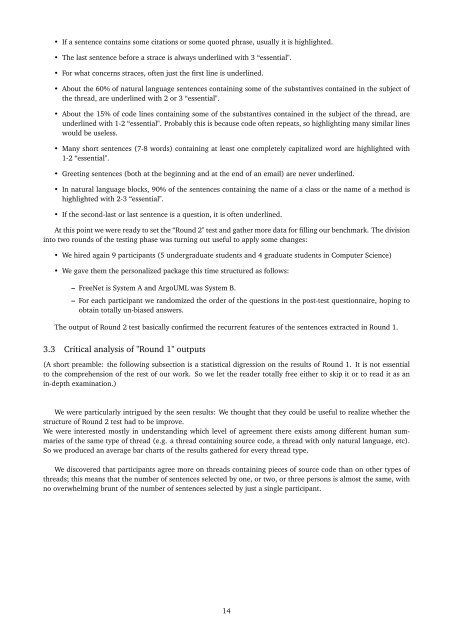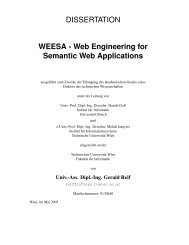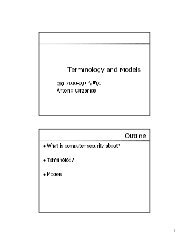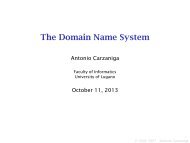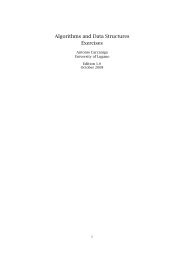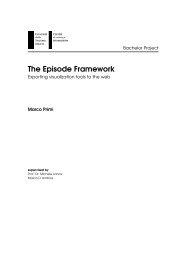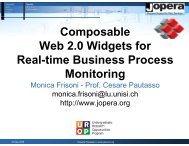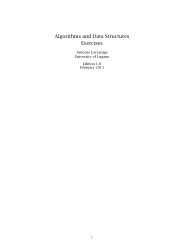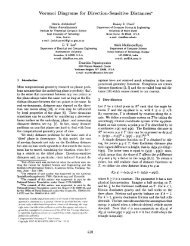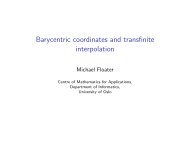Extractive Summarization of Development Emails
Extractive Summarization of Development Emails
Extractive Summarization of Development Emails
You also want an ePaper? Increase the reach of your titles
YUMPU automatically turns print PDFs into web optimized ePapers that Google loves.
• If a sentence contains some citations or some quoted phrase, usually it is highlighted.<br />
• The last sentence before a strace is always underlined with 3 “essential".<br />
• For what concerns straces, <strong>of</strong>ten just the first line is underlined.<br />
• About the 60% <strong>of</strong> natural language sentences containing some <strong>of</strong> the substantives contained in the subject <strong>of</strong><br />
the thread, are underlined with 2 or 3 “essential".<br />
• About the 15% <strong>of</strong> code lines containing some <strong>of</strong> the substantives contained in the subject <strong>of</strong> the thread, are<br />
underlined with 1-2 “essential". Probably this is because code <strong>of</strong>ten repeats, so highlighting many similar lines<br />
would be useless.<br />
• Many short sentences (7-8 words) containing at least one completely capitalized word are highlighted with<br />
1-2 “essential".<br />
• Greeting sentences (both at the beginning and at the end <strong>of</strong> an email) are never underlined.<br />
• In natural language blocks, 90% <strong>of</strong> the sentences containing the name <strong>of</strong> a class or the name <strong>of</strong> a method is<br />
highlighted with 2-3 “essential".<br />
• If the second-last or last sentence is a question, it is <strong>of</strong>ten underlined.<br />
At this point we were ready to set the “Round 2" test and gather more data for filling our benchmark. The division<br />
into two rounds <strong>of</strong> the testing phase was turning out useful to apply some changes:<br />
• We hired again 9 participants (5 undergraduate students and 4 graduate students in Computer Science)<br />
• We gave them the personalized package this time structured as follows:<br />
– FreeNet is System A and ArgoUML was System B.<br />
– For each participant we randomized the order <strong>of</strong> the questions in the post-test questionnaire, hoping to<br />
obtain totally un-biased answers.<br />
The output <strong>of</strong> Round 2 test basically confirmed the recurrent features <strong>of</strong> the sentences extracted in Round 1.<br />
3.3 Critical analysis <strong>of</strong> "Round 1" outputs<br />
(A short preamble: the following subsection is a statistical digression on the results <strong>of</strong> Round 1. It is not essential<br />
to the comprehension <strong>of</strong> the rest <strong>of</strong> our work. So we let the reader totally free either to skip it or to read it as an<br />
in-depth examination.)<br />
We were particularly intrigued by the seen results: We thought that they could be useful to realize whether the<br />
structure <strong>of</strong> Round 2 test had to be improve.<br />
We were interested mostly in understanding which level <strong>of</strong> agreement there exists among different human summaries<br />
<strong>of</strong> the same type <strong>of</strong> thread (e.g. a thread containing source code, a thread with only natural language, etc).<br />
So we produced an average bar charts <strong>of</strong> the results gathered for every thread type.<br />
We discovered that participants agree more on threads containing pieces <strong>of</strong> source code than on other types <strong>of</strong><br />
threads; this means that the number <strong>of</strong> sentences selected by one, or two, or three persons is almost the same, with<br />
no overwhelming brunt <strong>of</strong> the number <strong>of</strong> sentences selected by just a single participant.<br />
14


